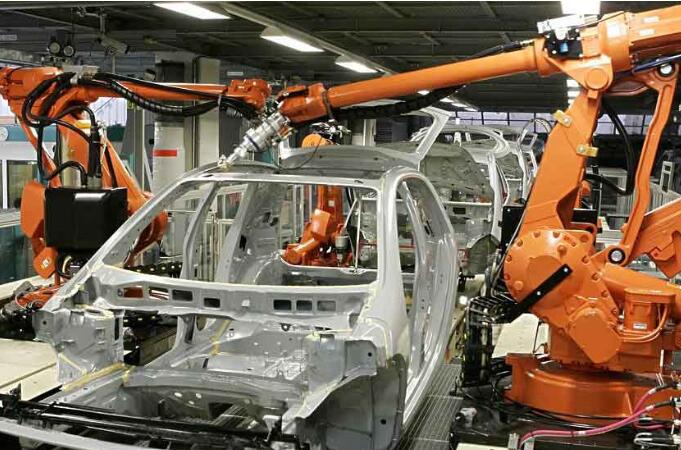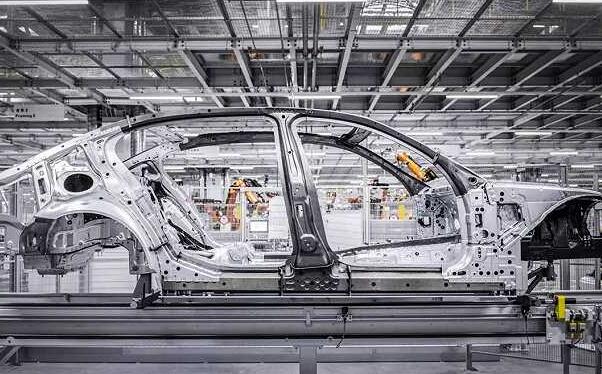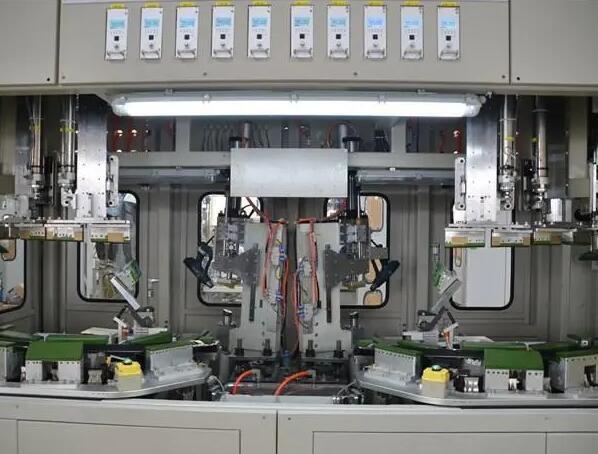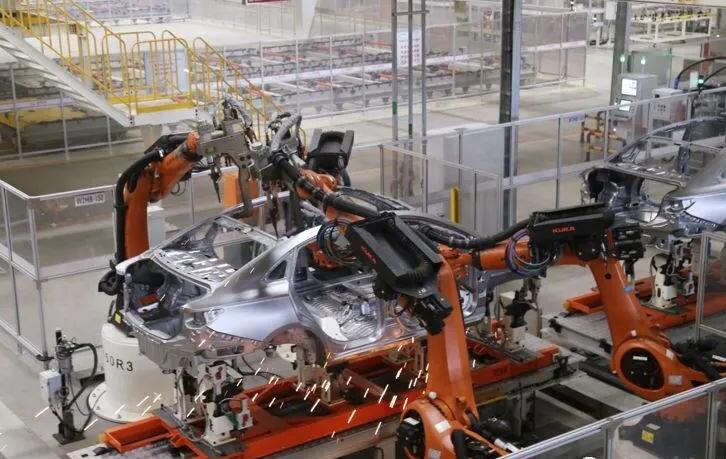
Your location : Home > Solution > Plastic welding technique
Welding technology in automobile production |
| Publisher: suzhou kailinneng automation equipment co., LTD Release time:2023-03-23 08:44:25 Click on the number of times:462 Shut down |
 |
| Welding is a necessary technology in modern machinery manufacturing industry and has been widely used in automobile manufacturing. With the progress of technology, new welding processes, new materials and new methods are constantly used in automobile manufacturing. The welding problems of coated steel plate, light metal materials, polymer materials, composite materials, dissimilar materials and special materials pose new challenges to automobile welding. The robot and automation technology in the process of automobile welding has greatly changed the appearance of automobile welding. I. New technology or new use of automobile welding Laser welding technique Laser technology uses a polarizing mirror to reflect the beam of light produced by the laser and concentrate it in a focusing device to produce a huge energy beam. If the focus is close to the workpiece, the workpiece will melt and evaporate in a few milliseconds. This effect can be used in welding process. The key of laser welding equipment is high power laser. There are two main categories, one is the solid state laser, also known as Nd: YAG laser. Nd (neodymium) is a rare earth group element, YAG stands for yttrium aluminum garnet, and its crystal structure is similar to ruby. Nd:YAG laser wavelength is 1.06mm, the main advantage is that the generated beam can be transmitted through optical fiber, so it can eliminate the complex beam transmission system, suitable for flexible manufacturing system or remote processing, usually used for welding workpiece with high precision requirements.
Nd:YAG lasers with output power of 3-4 kW are commonly used in the automotive industry. The other kind is gas laser, also known as CO2 laser, molecular gas as the working medium, produce an average of 10.6mm infrared laser, can work continuously and output high power, the standard laser power between 2-5 kW. Laser welding is characterized by minimal deformation of welded parts, almost no connection gap, welding depth/width ratio is high, so the welding quality is higher than the traditional welding method. However, such as to ensure the quality of laser welding, that is, laser welding process monitoring and quality control is an important content in the field of laser utilization, including the use of inductance, capacitance, acoustic wave, photoelectric and other sensors, through computer processing, for different welding objects and requirements, such as weld tracking, defect detection, weld quality monitoring and other projects, Automatic laser welding can be realized by adjusting welding process parameters through feedback control. In automobile industry, laser technology is mainly used in body welding, welding and parts welding. Plastic welding techniqueUltrasonic plastic welding is the transmission of high frequency mechanical vibration through the workpiece to the interface part, so that the molecular accelerated movement. The molecular friction is converted into heat to melt the plastic at the interface, thus making the two welds truly bonded as one in the way of molecular connection. Because this molecular movement is completed in an instant, so most of the ultrasonic plastic welding can be completed within 0.25 ~ 0.5s. Ultrasonic plastic welding is suitable for small welding area, regular structure and thermoplastic parts. 
Vibration friction plastic welding technology is to make the workpiece friction with each other under the condition of pressure, energy conduction along the welding part, and in the specially designed part of the plastic due to friction heat and melt, after the melting period in the state of continued pressure cooling and curing, solidified interface strength and body plastic strength. Branson's plastic welding technology has been successfully used in the automotive warranty bars, dashboards and dashboards, brake display lights, direction indicators, car door panels and other engine-related parts manufacturing industry. In recent years, many traditional metal components have been replaced with plastic, such as air intake pipes, instrument Pointers, radiator reinforcement, fuel tanks, filters, etc. Vibration friction welding is suitable for large welding area, complex structure of the workpiece, and has no special requirements for the type of plastic. Energy saving and control technology of resistance welding At present, resistance welders largely use 50Hz single-phase AC power supply with large capacity and low power factor. The development of three-phase low-frequency resistance welding machine, three-phase secondary rectifier contact welding machine (has been used in the common spot welding machine, seam welding machine, convex welding machine) and IGBT inverter resistance welding machine, can solve the problem of power imbalance and improve the power factor. At the same time, it can further save electric energy, which is conducive to realize the microcomputer control of parameters, and can be better applied to welding aluminum alloy, stainless steel and other difficult metal welding. In addition, it can further reduce the weight of the equipment. The PLC(programmable controller) intelligent controller was developed by Southwest Jiaotong University for the butt welding of aluminum alloy rim in a factory. The original machine was reformed, which solved the welding quality problem of aluminum alloy rim and improved the welding productivity. After the same factory developed PLC seam welding controller, to solve the general cleaning requirements of the parts seam welding problem. Through the development of these two controllers, it is proved that PLC has stronger anti-jamming ability and higher reliability than single chip microcomputer controller. Smaller than the industrial computer controller, low cost, the use of universal single-phase power frequency AC resistance welding machine to complete the difficult butt welding and seam welding work. Plasma welding (PAW) Like the TIG welding process, PAW welding robot applications are few and far between. This production is used for the welding of automotive fuel tanks, using different welding processes such as Tig-resistance spot welding and plasma welding, plasma welding process applied to the two semicircular edges of the tank. Many industries are interested in the further development of the plasma welding process. Specific developments will focus on the development of very high plasma densities and the redesign of plasma welding guns. Argon shielded plasma welding cutting has been used in various industries, mainly for alloy steel and nonferrous metal processing. At present, air plasma cutting has been widely used in steel and non-ferrous metal cutting. Domestic railway passenger car factory has introduced underwater plasma cutting to reduce deformation and improve accuracy. The engine valve body has been welded with filler ring plasma. Powder plasma surfacing has made great progress in recent ten years. It can be used for fine surfacing of thin layers with small fusion ratio, and can be used for surfacing of various special alloy surfaces. TCP automatic zero correction technology 
Automatic weld tracking technology The welding robot lacks the adaptive ability of the workpiece. The better effect is to use the laser vision sensor system, which can automatically identify the position of the weld, find and track the weld in the space, find the beginning and end of the weld, and realize the adaptive control of the welding gun following the position of the weld. However, this method is not suitable for the welding of the chassis parts of the car, because the clamp of the robot system of the chassis parts of the car allows the robot to work in a small range, and does not allow the welding of the welding gun head with laser tracking head. For this reason, the only available welding automatic tracking technology is arc voltage tracking sensor. The system has the ability to find the starting point, ending point and arc length reference point of the weld. In the welding process, according to the arc length changes, the arc sensor is used to control the voltage adaptive control. This method can only be applied to the form of corner joint. For a large number of thin plate lap welds of car chassis parts, it cannot be applied because it cannot find the reference point of arc length. Two. Automobile welding new materials In order to realize the lightweight of automobile and improve the safety of automobile, the application of high strength steel plate in automobile is increasing year by year, and there is a new generation of high strength steel plate material - ultra-fine grain steel. The steel mainly refers to the further improvement of economic indicators on the basis of steel material strength, toughness than the existing steel doubled. The new generation of ultrafine grain steel has the characteristics of ultrafine grain, high cleanliness and high uniformity. In the research of new generation iron and steel, there is no gap between China and the international level, almost at the same time, the leading position in the world coexistence with Japan and South Korea. NI-ROD Fe-Manganese filler metal, developed by SMC International Super Alloy Group Welding Products, is the first consumable successfully applied to this type of dissimilar welding, and its derivative NI-ROD? HT is suitable for increasing engine temperature. At the same time, the use of this kind of nickel-based consumables not only reduces the production cost, but also makes new progress in reducing the leakage rate and emission level of exhaust gas and reducing noise, so it has become a special welding material to optimize the production of automobile cast iron exhaust system. Until the 1890s, NI-ROD(r) filler metal was the welding consumable of choice between cast iron and stainless steel in the production of automobile exhaust devices in Western Europe and North America.However, in order to improve the efficiency of fuel combustion, the engine operating temperature has been raised in modern automobiles. As a result, the temperature of exhaust manifold has exceeded 750℃, and a new heat-affected zone cracking mode has been generated. This crack occurs along the fusion line along the heat affected zone due to a combination of dense network of secondary graphite precipitation, oxidation environment, and cyclic stresses caused by thermal cycling. This phenomenon has been defined as stress-accelerated oxidation (SAO). When the exhaust manifold is fitted to the automobile engine, with repeated engine operations, the martensite will be tempered and both the martensite and cementing will be dissolved and precipitated out again as secondary graphite. The more secondary graphite, the higher the possibility of SAO crack. Three. Automobile welding to intelligent 
Robot welding has been widely used in the automobile manufacturing industry, automotive chassis, seat frame, guide rail, muffler and hydraulic torque converter welding, especially in the automobile chassis welding production has been widely used. Toyota has decided to make spot welding standard for all of its spot welding robots in Japan and overseas. Welding quality can be improved with this technique, so it is even attempted to replace some arc welding jobs with it. The time of movement over short distances is also greatly shortened. The company recently introduced a low-altitude spot welding robot to weld underbody parts. The small spot welding robot can also be assembled with taller robots to work on the upper part of the car body, shortening the entire welding line. The domestic production of Santana, Passat, Buick, Sail, Polo and other rear axle, subframe, rocker arm, suspension, shock absorber and other car chassis parts are mainly mechanical safety parts based on MIG welding process, the main components are made of stamping welding, plate thickness is 1.5 ~ 4mm on average, welding mainly in lap joint, corner joint form, welding quality requirements are quite high. Its quality directly affects the safety performance of the car. Application of robot welding, greatly improve the appearance and internal quality of welding parts, and ensure the stability of quality and reduce labor intensity, improve the working environment. Automatic welding Throughout the current situation of welding in the automobile industry, it is not difficult to analyze the development trend of welding in the automobile industry: developing automatic flexible production system. Industrial robots, because of the combination of automation and flexible production characteristics, so car production in recent years large-scale, rapid use of robots. In welding, spot welding robot and arc welding robot are mainly used. Welding production line to a high degree of automation, widely used 6 degrees of freedom of the robot, and the robot has a welding clamp storage, according to the different requirements of the welding position or welding product changes, automatically from the storage grasp the required welding pliers. Transmission devices have been developed to use driverless, more flexible induction guided vehicles. There is a big gap between domestic and foreign automobile welding level. In recent years, domestic automobile manufacturers have attached great importance to the automation of welding. |
 Mobile web site!
Mobile web site!
